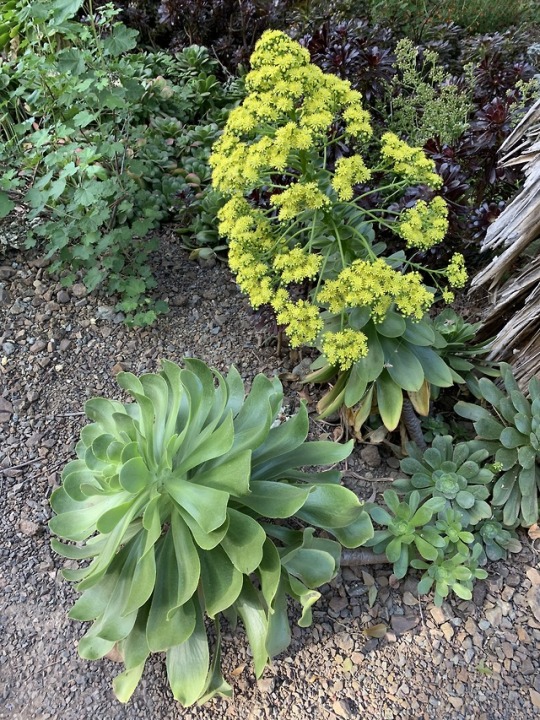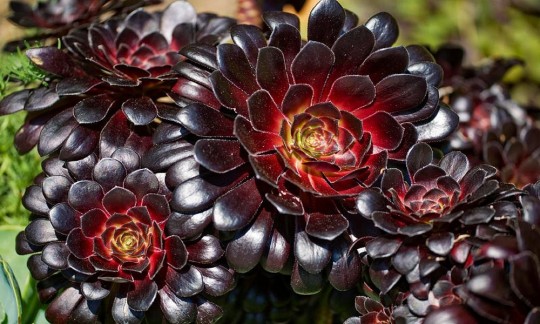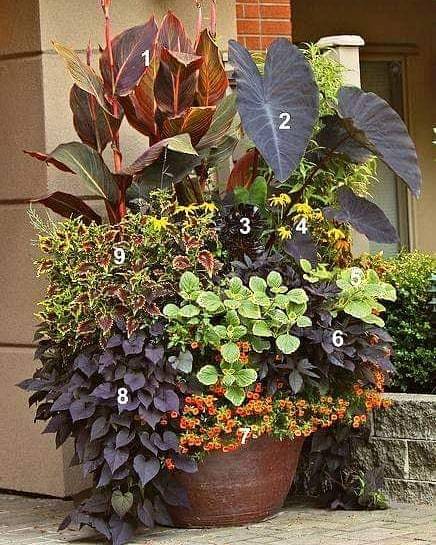#ZWARTKOP VAR
Text
Aeonium Zwartkop Bigbang

View On WordPress
0 notes
Photo


Aeonium arboreum var. holochrysum
Like Aeonium simsii, this species is native to the Canary Islands, but it is a much taller plant with much larger heads and many more flowers per flower stalk. It is most closely related to Aeonium arboreum, which tends to have somewhat smaller rosettes (though still much larger than Aeonium simsii). While the typical Aeonium arboreum often has purple-tinged leaves (sometimes strongly purple, as with the cultivar ‘Zwartkop’), the variety holochrysum is always green. The flower cluster is a little on the greenish side of yellow, as opposed to the golden-yellow of Aeonium simsii.
-Brian
25 notes
·
View notes
Photo



Aeonium species, Crassulaceae
This display of Aeonium species at the Winter Gardens combines the most striking cultivars from the Canary Islands Room at Glasgow Botanic Gardens, where many more plants native to the archipelago are grown together over a much larger space. If last year I missed the blooming of the Aeonium arboreum var. holochrysum grown there, here I found all the plants loaded with yellow, sun-shaped flowers. Not only the three spikes you see in the middle photo, but a few more around the place, as it’s one of the most commonly grown Aeoniums.
The dark-coloured rosettes highly contrasting against the green foliage are those of Aeonium arboreum ‘Zwartkop’ or ‘Schwarzkopf’, not nearly as dark and rose-bud shaped as it generally looks like when growing in parts of the world where the sun shines for a bit longer and a bit harder than here in Scotland. Lanky and floppy as it is, it’s still very noticeable.
The two large variegated rosettes belong to Aeonium arboreum ‘Sunburst’ and one is particularly interesting as it displays variegation mostly on one half.
In the foreground, the smaller and less commonly cultivated Aeonium gomerense, endemic to the island of La Gomera, covers the base of this well-planned, pyramidal show of Crassulaceae.
#aeonium#aeonium arboreum#aeonium holochrysum#aeonium zwartkop#aeonium sunburst#aeonium gomerense#plant identification#plant photography#botany#plantblr#horticulture#gardeners on tumblr#succulents#crassulaceae#ornamental plants#winter gardens#scotland#glasgow#greenhouse
56 notes
·
View notes
Text
Zwartkop
The Zwartkop (Aeonium arboreum) is also called the “black rose” because of its color and rosette shaped leaves. ‘Zwartkop’ comes from the Dutch name meaning “black head,” in reference to the plant’s dark rosette. It can also refer to the German name ‘Schwartzkopf’ or ‘Schwarzkopf,’ both of which mean “black head.” It can grow up to 5-6 feet tall. This succulent is also deer resistant like many other succulents.

Photo from: https://www.gardeningexpress.co.uk/aeonium-arboreum-var-atropurpureum-zwartkop-schwarzkopf-black-tree-aeonium
In winter, this plant produces yellow flowers that create a beautiful and unexpected contrast to its dark foliage. This succulent prefers to be in full sun exposure. The Zwartkop need well drained soil in order to survive and flourish. While the Zwartkop can tolerate mild frost and freezing temperatures, it can only do so for short periods of time. Prolonged exposure to freezing temperatures is not advisable and may damage the plant permanently.
Zwartkops are monocarpic plants so they die after they flower. Aeonium arboreum produces elaborate flowers that protrude out from the center of the rosette. These flowers are showy and are not hard to miss. They are usually yellow in color and contrast well with the dark foliage of the plant. I think that this succulent is very unique because of its color, it is also very fun to pronounce its name.
Sources from:
https://www.ftd.com/blog/share/types-of-succulents
https://succulentplantcare.com/aeonium-arboreum-zwartkop-black-rose-care-and-propagation/
https://www.gardenia.net/plant/aeonium-zwartkop
0 notes
Text
Best Black Flowers
OK, they are not exactly black, but they are beautiful! Whether you fancy deep purple, wine red or rich chocolate, dark flowers and foliage can transform tired borders. We round up some of the most delectable dark delights to try
Black Beauties Black Gamecock Louisiana Iris Credit Alamy G35D6H
Best Black Flowers
There’s something alluring about dark plants. Flowers that smoulder in shades of midnight navy, damson black and velvet crimson; sultry black and maroon foliage – woven in amongst other plants, both will give gardens an instant lift, creating a mood that is both stylish and modern.
The secret lies in being sparing: only a few splashes of witches’ purple and deep claret are needed – too many and the tone becomes morbid. If you already have dark plants, such as a yew tree or a leylandii, go easy; otherwise your garden could start to resemble a graveyard.
However in the average summer border, where bright colours tend to dominate, the addition of a few dark flowers such as chocolate cosmos (Cosmos atrosanguineus) and port-coloured hollyhock (Alcea rosea ‘Nigra’) will have a stunning effect.
amateurgardening.com/how-to
Alcea rosea ‘Nigra’. Credit: Alamy
Contrasting Colours
Dark tones act as great foils for other colours. They contrast with paler shades (pastel pinks and lavender blues) and fiery tones (such as orange and red). Their dark colouring breaks up the monotony of a lighter planting scheme, acting as punctuation marks.
Many dark beauties can go in the ground now. Bearded irises (such as ‘Ghost Train’) can be planted in sun-baked borders, and the moisture-loving black Iris chrysographes can be added to bog gardens for late spring flowers.
Plants that inject winter interest can also be planted, like black-stemmed bamboo (Phyllostachys nigra) and dogwood (Cornus alba) ‘Kesselringii’, which has beetroot black stems in cold months.
Likewise, if you fancy some dark hellebores, this month is a good time to plant them.
Plant black-stemmed bamboo now for winter interest. Credit: Alamy
Others will need you to be a little more patient. Wait until late autumn to plant the almost-black tulip ‘Queen of Night’ and the dangerously dark climbing rose ‘Souvenir du Docteur Jamain’.
Hold off until April to sow seed of mulberry-coloured ‘Claret’ sunflowers and nasturtium ‘Black Velvet’, or to plant Cotinus coggygria ‘Royal Purple’ and Aeonium ‘Zwartkop’ – a must for their seductive burgundy-plum leaves.
The results will be well worth it. Just a few dark flowers or foliage plants are all it takes to totally transform a garden, giving borders a contemporary boost that will make them sizzle with drama.
amateurgardening.com/how-to
Best Black Flowers
Papaver Somniferum. Credit: Alamy
Papaver somniferum Single black-flowered
Opium poppies like this dark plum beauty can be sown indoors in September, or direct in April. Remove the seedheads promptly if you don’t want them to self-sow. H: 3ft (90cm). Supplier: Sarah Raven.
Iris ‘Black Suited’. Credit: Alamy
Iris ‘Black Suited’
The majestic flowers of this bearded iris are the deep purple-black of midnight. Plant them now or in the autumn, in sun-baked, well-drained soil, and make sure they have plenty of elbow room. H: 3ft (90cm). Supplier: Iris Of Sissinghurst.
Centaurea ‘Black Ball’. Credit: Alamy
Centaurea cyanus ‘Black Ball’
Cornflowers are an essential wildlife plant; to keep things contemporary, opt for deep burgundy over classic blue. Sow under glass in September, or direct sow in well-drained, sun-baked soil in April. H: 3ft (90cm). Supplier: RHS Plants.
Aquilegia ‘Black Barlow’. Credit: Alamy
Aquilegia vulgaris var. stellata ‘Black Barlow’
Damson pompom flowers adorn this columbine when it blooms in late spring and early summer. Grow in moisture-retentive, well-drained soil, in sun or semi-shade. H: 21⁄2ft (75cm). Supplier: Chiltern Seeds.
Dusky Cranesbill. Credit: Alamy
Geranium phaeum
The dusky cranesbill (also known as black widow) is a useful perennial that produces its maroon flowers in late spring. Great with ferns, it favours semi-shade but will tolerate dry shade. H: 21⁄2ft (75cm). Supplier: Crocus.
3 Plants For Dark Foliage
Ophiopogon planiscapus ‘Kokuryu’. Credit: Alamy
Ophiopogon planiscapus ‘Kokuryu’ AGM
A low evergreen grass with strappy black leaves, ‘Kokuryu’ provides useful ground cover in moist, well-drained, acid-to-neutral soil. Mauve summer flowers are followed by blue berries. H: 8in (20cm).
Heuchera ‘Obsidian’ AGM
The glossy chocolate leaves of this semi-evergreen perennial are complemented by tiny cream summer flowers. Plant now, in humus-rich soil in sun or semi-shade. H: 11⁄2ft (45cm).
Anthriscus sylvestris ‘Ravenswing’
Form of cow parsley with wine-brown foliage and lacy white May flowers. Seedlings of regular cow parsley can appear and should be weeded out. Sow now or in September. H: 3ft (90cm).
amateurgardening.com/how-to
Dark leaves or flowers work best with contrasting colours. Credit: Alamy
Don’t Forget…
• Contrast: Plant alongside pale foliage and flowers so black hues stand out. Soft blues work well with burgundy.
• Foil: Dark plants act as great foils to fiery colours (such as orange), helping to tie them into the border.
• Less is more: Don’t get carried away: a few purple-black plants add sophistication; too many will make your plot look like Morticia’s garden!
Main image: Black Gamecock Louisiana Iris (Credit: Alamy)
Words: Hazel Sillver
via RSSMix.com Mix ID 8135640 https://ift.tt/32SUbMQ
0 notes
Photo

(1) Tropicanna Black cannas, (2) Colocasia esculenta ‘Black Magic’, (3) Aeonium 'Zwartkop', (4) Rudbeckia fulgida var. sullivantii 'Goldsturm', (5) Plectranthus 'Lemon Twist', (6) Ipomoea 'Sweet Caroline Purple', (7) Calibrachoa 'Callie Orange', (8) Ipomoea 'Sweetheart Purple' and (9) Coleus 'Sky Fire' https://www.instagram.com/p/BpdQEdZHLaQ-trwRuA_aTiKFd8_HAlDEc-Gsho0/?utm_source=ig_tumblr_share&igshid=1u7o3tit969vc
0 notes